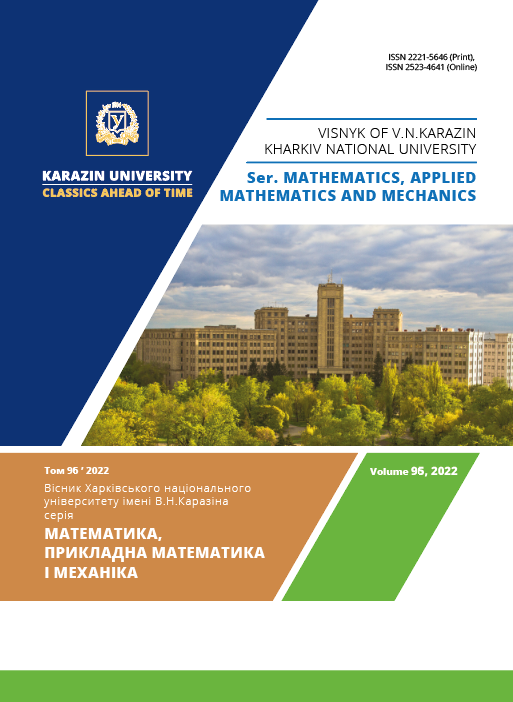Явний вигляд поверхні перемикання в задачі допустимого позиційного синтезу
Анотація
В цій статті розглядається проблема, пов'язана із задачею допустимого позиційного синтезу та методом функції керованості, а саме, з допустимим принципом максимуму. На відміну від більш звичого підходу, допустимий принцип максимуму дає розривний розв'язок задачі синтезу. Нехай задана канонічна керована система $\dot{x}_i=x_{i+1}, i=\overline{1,n-1}, \dot{x}_n=u$ з обмеженнями на керування вигляду $|u| \le d$. Задача синтезу для довільної лінійної системи вигляду $\dot{x} = A x + b u$ може бути зведена до канонічної. Функція керованості $\Theta(x)$ задана як єдиний додатний розв'язок деякого рівняння $\Phi(x, \Theta) = 0$. Керування обирається таким чином, щоб мінімізувати похідну функції $\Theta(x)$ за часом в кожній точці, і воно може бути записано у вигляді $u(x) = -d \text{ sign}(s(x,\Theta(x)))$. Множина точок, що задовольняє рівності $s(x,\Theta(x)) = 0$, називається поверхнею перемикання і визначає точки, де керування змінює свій знак. Зазвичай вона включає змінну $\Theta$, що є неявним розв'язком рівняння $\Phi(x, \Theta) = 0$. В цій роботі ми шукаємо явне представлення поверхні перемикання, тобто таке, що не включає зміної $\Theta$. В нашому випадку вирази $\Phi(x, \Theta)$ та $s(x, \Theta)$ є поліномами відносно $\Theta$, тому задача пов'язана з задачею знаходження умов при яких два поліноми мають спільний додатний корінь. Раніше було відомо рішення для 2-вимірного випадку. Але в ході дослідження з'ясувалося, що для систем більшої розмірності існують певні труднощі. У цій статті представлено та досліджено поверхню перемикання для тривимірного випадку. Також показано, що ця поверхня перемикання є поверхнею ковзання (згідно з визначенням Філіппова). В роботі також запропоновані інші способи побудови поверхні перемикання за допомогою інтерполяції та апроксимації. Ці способи застосовано для знаходження траєкторій конкретних початкових точок.Завантаження
Посилання
A.M. Lyapunov, The General Problem of the Stability of Motion. - 1892. Kharkov Mathematical Society, Kharkov. English translation: The general problem of the stability of motion (trans. A.T. Fuller), in International Journal of Control, 55:3, 531-573. 1992 DOI: https://doi.org/10.1080/00207179208934253
L. S. Pontryagin, V. G. Boltyanskii, R. V. Gamkrelidze, E. F. Mishechenko, The Mathematical Theory of Optimal Processes. VIII + 360 S. New York/London 1962. John Wiley & Sons. Preis 90/-. DOI: https://doi.org/10.1002/zamm.19630431023
R. Kalman, Y. Ho, K. Narendra, Controllability of linear dynamical systems. Contributions to Differential Equations 1. - 1963, 189-213.
V. I. Korobov. A general approach to the solution of the bounded control synthesis problem in a controllability problem, Math. USSR Sb. 37. - 1980. - No. {bf 4}, 535-557. DOI: https://doi.org/10.1070/SM1980v037n04ABEH002094
V. I. Korobov, G. M. Sklyar. Time optimality and the power moment problem. Mat. Sb., Nov. Ser. 134(176). - 1987. no. 2(10), 186-206; Math. USSR, Sb. 62. - 1989. No. 1, 185-206. DOI: https://doi.org/10.1070/SM1989v062n01ABEH003235
V. I. Korobov, G. M. Sklyar. Methods for constructing of positional controls and an admissible maximum principle, Differ. Equations 26 (1990), Vol. 11, 1422-1431.
V.I. Korobov, Method of controllability function, R$&$C Dynamics, Moskow-Ijevsk, 2007. ISBN 978-5-93972-610-8.
A. F. Filippov, Differential equations with discontinuous right-hand side, Mat. Sb. (N.S.), 51(93):1 (1960), 99-128.
Автори, які публікуються у цьому журналі, погоджуються з наступними умовами:
1. Автори залишають за собою право на авторство своєї роботи та передають журналу право першої публікації цієї роботи на умовах ліцензії Creative Commons Attribution License, котра дозволяє іншим особам вільно розповсюджувати опубліковану роботу з обов'язковим посиланням на авторів оригінальної роботи та першу публікацію роботи у цьому журналі. (Attribution-Noncommercial-No Derivative Works licence).
2. Автори мають право укладати самостійні додаткові угоди щодо неексклюзивного розповсюдження роботи у тому вигляді, в якому вона була опублікована цим журналом (наприклад, розміщувати роботу в електронному сховищі установи або публікувати у складі монографії), за умови збереження посилання на першу публікацію роботи у цьому журналі.
3. Політика журналу дозволяє і заохочує розміщення авторами в мережі Інтернет (наприклад, у сховищах установ або на особистих веб-сайтах) рукопису роботи, як до подання цього рукопису до редакції, так і під час його редакційного опрацювання, оскільки це сприяє виникненню продуктивної наукової дискусії та позитивно позначається на оперативності та динаміці цитування опублікованої роботи (див. The Effect of Open Access).




